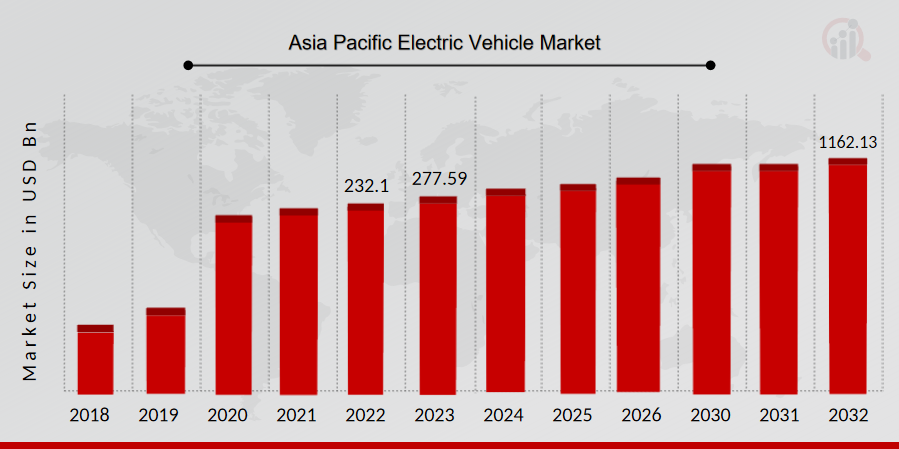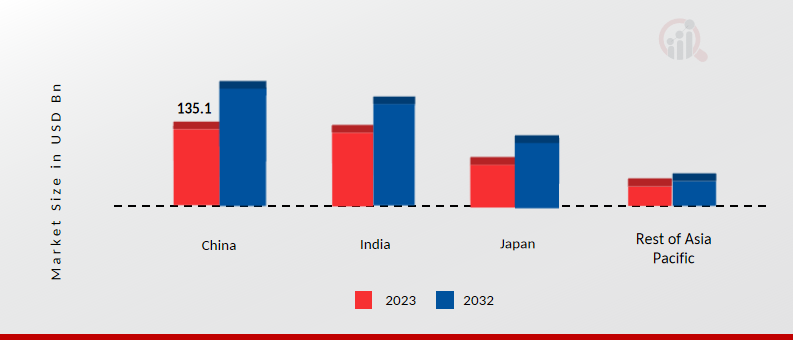Asia Pacific Electric Vehicle Market Overview
Asia Pacific Electric Vehicle Market Size was valued at USD 232.1 Billion in 2022. The Electric Vehicle market industry is projected to grow from USD 277.59 Billion in 2023 to USD 1162.13 Billion by 2032, exhibiting a compound annual growth rate (CAGR) of 19.60% during the forecast period (2024 - 2032). An increase in automobile sales worldwide is one of the major market drivers of the electric vehicle market in Asia Pacific. Governments are making direct investments in public charging infrastructure or indirectly funding private charging stations for use in homes and offices.

Source: Secondary Research, Primary Research, MRFR Database and Analyst Review
Asia Pacific Electric Vehicle Market Trends
-
An increase in automobile sales worldwide is driving market growth
The Asia Pacific Electric Vehicle market CAGR is expanding. Electric vehicles (EVs) are automobiles driven by one or more electric motors. It can run on a self-contained battery (which is occasionally charged by solar panels or by converting gasoline into energy using fuel cells or a generator), an extra-vehicular electricity source, or a collecting system. Due to the fact that they run on electricity, electric vehicles provide a number of benefits over traditional fuel-powered vehicles, such as reduced running costs and no carbon emissions. As people grow increasingly worried about environmental pollution, their attitudes toward electric vehicles are shifting, which is driving industry growth. Globally, governments are investing more in electric vehicles. Government investments to upgrade public EV charging infrastructure, rules to phase out fossil fuel-powered vehicles, and programs to promote EV adoption through tax breaks and subsidies are all anticipated to help market expansion. Governments are making investments in the infrastructure needed for charging, either directly through public charging stations or indirectly through financial assistance for private charging stations installed in homes and businesses.
Furthermore, the rise in EV sales globally is one of the key reasons propelling the expansion of the electric vehicle industry. Consumer preference is quickly moving toward electric vehicles (EVs) for both personal and commercial use as a result of growing environmental concerns. The market is growing more quickly because of the global increase in luxury car manufacturing and sales brought on by rising disposable income. Car production is rising as a result of the growing demand for these upgraded automobiles. From 2022 to 2029, there will be lucrative prospects for market participants due to the high demand for electric vehicles in the automotive and transportation industries. Additionally, the market for electric vehicles will expand more quickly due to government activities related to EVs. Thus, result in driving the Electric Vehicle market revenue.
Asia Pacific Electric Vehicle Market Segment Insights
-
Electric Vehicle Propulsion Type Insights
The Asia Pacific Electric Vehicle market segmentation, based on Propulsion Type, includes Battery Electric Vehicles, Hybrid Electric Vehicles, Fuel Cell Electric Vehicles, and Plug-in Hybrid Electric Vehicles. The battery electric vehicles segment dominated the market. The leading market share of this segment can be ascribed to regulations on vehicular CO2 emissions as well as consumers' growing preference for EVs over ICE cars. In the future, BEVs may be able to drastically cut both the total cost of ownership and vehicle emissions. Over the projection period, declining lithium-ion battery prices and advances in battery technology are also anticipated to fuel BEV demand.
-
Electric Vehicle Type Insights
The Asia Pacific Electric Vehicle market segmentation, based on Vehicle Type, includes Passenger Car and Commercial Vehicles. The commercial vehicles category generated the most income. The rise in fuel prices and government-imposed strict pollution regulations, as well as the expanding use of autonomous delivery vehicles and electric buses and trucks, are the primary factors contributing to this segment's rapid growth.
-
Electric Vehicle Charging Type Insights
The Asia Pacific Electric Vehicle market segmentation, based on Charging Type, includes Normal Charging and Fast Charging. The fast-charging category generated the most income. The development of fast charging station infrastructure to enable automakers' long-range battery-electric vehicles and the expanding government discounts on the acquisition of fast charging stations are anticipated to fuel the segment's expansion.
Figure 1: Asia Pacific Electric Vehicle Market, by Charging Type, 2023 & 2032 (USD Billion)

Source: Secondary Research, Primary Research, MRFR Database and Analyst Review
Electric Vehicle Country Insights
Growing government laws that encourage the use of electric vehicles and the robust expansion strategies used by OEMs and suppliers in the area to meet the growing demand from China's automotive industry are anticipated to provide a good outlook for market growth over the course of the projected period. For example, the Chinese government is pushing for the adoption of electric cars. The nation has already established plans to gradually phase out the diesel fuel used to power the nation's modern tractors and construction machinery. By 2040, all gasoline and diesel cars are to be outlawed in the nation. A total order for 1,002 pure-electric buses to be supplied to Bogota, Colombia, was also announced by BYD in January 2021. It is planned for these buses to be delivered starting in 2021 and continuing through the first half of 2022.
Figure 2: Asia Pacific Electric Vehicle Market Share By Region 2023 & 2032 (USD Billion)

Source: Secondary Research, Primary Research, MRFR Database and Analyst Review
Asia Pacific Electric Vehicle Key Market Players & Competitive Insights
Leading market players are putting a lot of money into R&D to expand their product lines, which will spur additional expansion in the electric vehicle market. In addition, market players are engaging in a range of calculated initiatives to increase their presence, with important market developments involving the introduction of new products, contracts, M&A transactions, increased investment, and cooperation with other enterprises. To grow and endure an increasingly cutthroat and dynamic market, the Electric Vehicle industry must offer cost-effective items.
Major players in the Electric Vehicle market are engaging in research and development activities in an effort to boost market demand, including Tesla Inc, Mercedes-Benz Group AG, BYD Company Ltd, General Motors, Toyota Motor Corporation, Hyundai Motor Company, Honda Motor Company Ltd, Nissan Motor Co. Ltd, Volkswagen AG, and Stellantis NV.
Key Companies in the Asia Pacific Electric Vehicle market include
- Tesla Inc
- Mercedes-Benz Group AG
- BYD Company Ltd
- General Motors
- Toyota Motor Corporation
- Hyundai Motor Company
- Honda Motor Company Ltd
- Nissan Motor Co. Ltd
- Volkswagen AG
- Stellantis NV
Asia Pacific Electric Vehicle Industry Developments
May 2022: An enhanced Nexon EV with a stated driving range of more than 400 km on a single charge is set to debut in India, according to a statement released by Tata Motors.
May 2022: Toyota announced that it will launch its new battery-powered SUV, the bZ4X, in Japan. Toyota's first vehicle on a specially engineered electric vehicle platform, which it developed alongside Subaru, is the bZ4X.
February 2022: BYD, a Chinese EV company, has launched the Yuan Plus model, which is powered by a Blade battery. It has two battery choices: a 49-kWh battery and a higher-range 60.48-kWh battery.
Asia Pacific Electric Vehicle Market Segmentation
Electric Vehicle Propulsion Type Outlook
- Battery Electric Vehicles
- Hybrid Electric Vehicles
- Fuel Cell Electric Vehicles
- Plug-in Hybrid Electric Vehicles
Electric Vehicle Vehicle Type Outlook
- Passenger Car
- Commercial Vehicles
Electric Vehicle Charging Type Outlook
- Normal Charging
- Fast Charging
Electric Vehicle Regional Outlook
Asia Pacific
- China
- Japan
- ndia
- Australia
- South Korea
- Indonesia
- Thailand
- Vietnam
- Malaysia
- Singapore
- Rest of Asia-Pacific
| Report Attribute/Metric |
Details |
| Market Size 2022 |
USD 232.1 Billion |
| Market Size 2023 |
USD 277.59 Billion |
| Market Size 2032 |
USD 1162.13 Billion |
| Compound Annual Growth Rate (CAGR) |
19.60% (2024-2032) |
| Base Year |
2023 |
| Market Forecast Period |
2024-2032 |
| Historical Data |
2019- 2022 |
| Market Forecast Units |
Value (USD Billion) |
| Report Coverage |
Revenue Forecast, Market Competitive Landscape, Growth Factors, and Trends |
| Segments Covered |
Propulsion Type, Vehicle Type, Charging Type, and Region |
| Region Covered |
Asia Pacific |
| Countries Covered |
China, Japan, India, Australia, South Korea, Indonesia, Thailand, Vietnam, Malaysia, Singapore, and Rest of Asia-Pacific |
| Key Companies Profiled |
Tesla Inc, Mercedes-Benz Group AG, BYD Company Ltd, General Motors, Toyota Motor Corporation, Hyundai Motor Company, Honda Motor Company Ltd, Nissan Motor Co. Ltd, Volkswagen AG, and Stellantis NV |
| Key Market Opportunities |
· Favorable investments and policies of the government |
| Key Market Dynamics |
· High uptake in the transportation industry · Global EV sales are rising, which is contributing to the expansion of the electric vehicle market. |
Frequently Asked Questions (FAQ) :
In 2023, the market for electric vehicles in Asia Pacific was estimated to be worth USD 277.59 billion.
The market is anticipated to expand at a compound annual growth rate (CAGR) of 19.60% from 2024 to 2032.
Tesla Inc., General Motors, BYD Company Ltd., Mercedes-Benz Group AG, Toyota Motor Corporation, Hyundai Motor Company, Honda Motor Company Ltd., Nissan Motor Co. Ltd., Volkswagen AG, and Stellantis NV are the major players in the market.
In 2023, the market was dominated by the Battery Electric Vehicles category
The market share leader was the Commercial Vehicles category
















